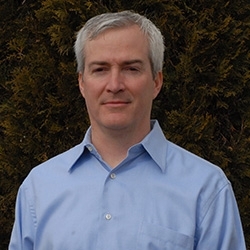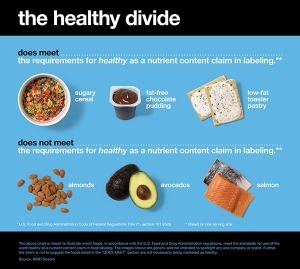Sean Moloughney07.01.08
Bombarded by an overload of nutritional information for decades, consumers will soon be armed with what many experts view as the world’s most sophisticated standard in measuring nutritional quality.
Three major U.S. supermarket chains, which have yet to be named, will adopt the NuVal Nutritional Scoring System this September, launching the Overall Nutritional Quality Index (ONQI), which weighs 30 different nutrient markers through a proprietary algorithm, onto supermarket shelves.
“The world of nutritional information is hopelessly befuddling,” admitted David Katz, MD, MPH, who led a panel of about a dozen medical and nutrition experts from leading North American universities and health organizations in developing the ONQI over a two-year period. “But it occurred to me we have the wherewithal to fix that. Our mission was to develop the best possible nutrition guidance system. And we built the best model science would allow.”
This comprehensive rating system measures a food’s nutritional value on a scale of one to 100 based on a complex set of factors that includes levels of fiber, folate, vitamins A, C, D, E, B12, B6, potassium, calcium, zinc, omega 3 fatty acids, carotenoids, magnesium, iron, saturated fat, trans fat, sodium, sugar, cholesterol, fat quality, protein quality, energy density and glycemic load.
A higher ONQI score reflects foods with higher nutritional value, offering consumers the opportunity to evaluate products within and across specific food categories. So shoppers can literally compare apples to oranges, or almonds to apricots, strawberries to yogurt, chocolate to, well, anything. By the way, for those of you keeping score at home, strawberries win with an ONQI rating of 100.
Perhaps at the heart of the equation, the ONQI accounts for a range of epidemiological information, including weighted coefficients for prevalence and severity of various diseases and health conditions affecting the population.
“Sodium is a nutrient consumed in excess in this country and it is associated with high blood pressure,” Dr. Katz offered as an example. “But on the other hand it is an essential nutrient. What you want to penalize is the excess of sodium, so a certain amount is exonerated.” These coefficients and the inherent precision of the ONQI algorithm help contribute to its validity and utility.
Dr. Katz explained the basic formula is based on Dietary Reference Intakes (DRIs), FDA Nutrition Facts Panel, USDA MyPyramid, Dietary Guidelines for Americans (2005) and relevant international standards.
“Every nutrient entered is entered from a ‘diet-eye-view.’ It’s not about one individual food, but the pattern of diet over a typical day,” he added. “How is this food contributing to the overall pattern of your diet? The ONQI answers the question ‘How does the concentration of a particular nutrient in a food compare to the recommended amount of that nutrient in a healthy diet?’” The answer is quantified through a novel, patent-pending concept called the “trajectory score.”
While scientists have spent the past two years developing this sophisticated tool designed to empower the average consumer, the idea stems back to 2003, when the U.S. Secretary of Health & Human Services convened a group to share ideas, generally, for improving dietary intake patterns in the U.S., and, specifically, for stemming the spread of obesity.
At that time Dr. Katz offered his idea for a comprehensive nutritional rating system. “There was philosophical support for the concept,” he recalled. “But it requires a great deal of political will to do this.”
Absent that will, Dr. Katz would tap other resources in the medical and academic sector, teaming up with Griffin Hospital, a Yale-affiliated, non-profit community hospital in Derby, CT—and home to Yale University’s Prevention Research Center—which agreed to offer financial and material support. An all-star panel of health professionals convened in late 2005, and the first draft of the ONQI algorithm was created in February 2006. A similar panel of experts currently serves as the Science Advisory Board, responsible for managing the scientific integrity of the system.
Ultimately, by developing this algorithm, the group’s mission was to put power back into the hands of the public, offering them a means to improve dietary intake patterns, and thereby health, one food choice at a time.
“With great power comes great responsibility,” Dr. Katz said. “If we want to empower consumers we have the responsibility to offer them information they can understand.”
Partnering with Griffin Hospital in the effort to release the ONQI was Topco Associates, LLC, Skokie, IL, a privately held company that provides innovative solutions for its food industry member-owners and customers, which include supermarket retailers, wholesalers, and foodservice companies. NuVal, LLC, is the joint venture between Topco and Griffin Hospital, formed to bring the ONQI to market.
The NuVal Nutritional Scoring System itself is designed to have applications at point of purchase in retail supermarkets and online. Ultimately, the NuVal score will be available on food packaging and in restaurants.
The first three grocery chains to use the NuVal system will be named publicly in September, marking the first wave of an education program that is expected to expand nationwide by this time next year.
NuVal’s double-hexagon emblem, bearing the score of each individual product, will appear on shelf tags next to the price. Retailers will use banners, shelf-talkers, brochures, associate training and other forms of in-store communication to tell the NuVal story.
“Consumers want clear information about the nutritional value of the foods they eat, and NuVal scores are going to give it to them,” said NuVal president Nancy McDermott. “We’ve got the scientific foundation, the logistical ability and the retail partners needed to bring this important education to consumers coast to coast.”
On average, there are approximately 40,000 products in a typical U.S. supermarket, and the NuVal system intends to rate all of them by September 2009.
An online database where consumers can view ONQI scores for foods, beverages and recipes is also expected to launch later this summer or early fall. The database will continue to grow with updates and “recipe makeovers,” according to Dr. Katz, who said he also expects an ONQI handbook to be released around March 2009.
So far, Dr. Katz said his team has received overwhelmingly positive feedback from consumers and health professionals. “Most of the feedback was ‘What took you so long?’ We’ve had dieticians rubbing their hands together in glee. I think it will be overwhelmingly embraced.”
While it is not the first nutrition rating system, Dr. Katz argues that the ONQI is the “world’s most sophisticated standard in measuring nutritional quality.”
In 2006, Portland, ME-based Hannaford Bros. launched its Guiding Stars rating system throughout its 164 supermarkets across New England and New York. Developed by nutrition scientists and other health experts, products receive a rating of one, two or three stars, based on the presence of vitamins, minerals, dietary fiber and whole grains. The system also factors for added sugar and levels of saturated fat, cholesterol and sodium.
More than 70% of the products evaluated received no stars at all, which, Dr. Katz points out, really doesn’t give consumers much direction. Yet sales of products with stars have spiked, at points by large margins, compared to those without.
Similarly, Dr. Katz hopes that widespread adoption of the ONQI system will have an impact on consumer buying patterns, and consequently, food manufacturers’ formulation practices.
“We really want to influence demand and supply,” he said. “Any food manufacturer that improves the nutritional quality of a product will get credit on the ONQI scale.”
Three major U.S. supermarket chains, which have yet to be named, will adopt the NuVal Nutritional Scoring System this September, launching the Overall Nutritional Quality Index (ONQI), which weighs 30 different nutrient markers through a proprietary algorithm, onto supermarket shelves.
“The world of nutritional information is hopelessly befuddling,” admitted David Katz, MD, MPH, who led a panel of about a dozen medical and nutrition experts from leading North American universities and health organizations in developing the ONQI over a two-year period. “But it occurred to me we have the wherewithal to fix that. Our mission was to develop the best possible nutrition guidance system. And we built the best model science would allow.”
This comprehensive rating system measures a food’s nutritional value on a scale of one to 100 based on a complex set of factors that includes levels of fiber, folate, vitamins A, C, D, E, B12, B6, potassium, calcium, zinc, omega 3 fatty acids, carotenoids, magnesium, iron, saturated fat, trans fat, sodium, sugar, cholesterol, fat quality, protein quality, energy density and glycemic load.
A higher ONQI score reflects foods with higher nutritional value, offering consumers the opportunity to evaluate products within and across specific food categories. So shoppers can literally compare apples to oranges, or almonds to apricots, strawberries to yogurt, chocolate to, well, anything. By the way, for those of you keeping score at home, strawberries win with an ONQI rating of 100.
Perhaps at the heart of the equation, the ONQI accounts for a range of epidemiological information, including weighted coefficients for prevalence and severity of various diseases and health conditions affecting the population.
“Sodium is a nutrient consumed in excess in this country and it is associated with high blood pressure,” Dr. Katz offered as an example. “But on the other hand it is an essential nutrient. What you want to penalize is the excess of sodium, so a certain amount is exonerated.” These coefficients and the inherent precision of the ONQI algorithm help contribute to its validity and utility.
Dr. Katz explained the basic formula is based on Dietary Reference Intakes (DRIs), FDA Nutrition Facts Panel, USDA MyPyramid, Dietary Guidelines for Americans (2005) and relevant international standards.
“Every nutrient entered is entered from a ‘diet-eye-view.’ It’s not about one individual food, but the pattern of diet over a typical day,” he added. “How is this food contributing to the overall pattern of your diet? The ONQI answers the question ‘How does the concentration of a particular nutrient in a food compare to the recommended amount of that nutrient in a healthy diet?’” The answer is quantified through a novel, patent-pending concept called the “trajectory score.”
While scientists have spent the past two years developing this sophisticated tool designed to empower the average consumer, the idea stems back to 2003, when the U.S. Secretary of Health & Human Services convened a group to share ideas, generally, for improving dietary intake patterns in the U.S., and, specifically, for stemming the spread of obesity.
At that time Dr. Katz offered his idea for a comprehensive nutritional rating system. “There was philosophical support for the concept,” he recalled. “But it requires a great deal of political will to do this.”
Absent that will, Dr. Katz would tap other resources in the medical and academic sector, teaming up with Griffin Hospital, a Yale-affiliated, non-profit community hospital in Derby, CT—and home to Yale University’s Prevention Research Center—which agreed to offer financial and material support. An all-star panel of health professionals convened in late 2005, and the first draft of the ONQI algorithm was created in February 2006. A similar panel of experts currently serves as the Science Advisory Board, responsible for managing the scientific integrity of the system.
Ultimately, by developing this algorithm, the group’s mission was to put power back into the hands of the public, offering them a means to improve dietary intake patterns, and thereby health, one food choice at a time.
“With great power comes great responsibility,” Dr. Katz said. “If we want to empower consumers we have the responsibility to offer them information they can understand.”
Partnering with Griffin Hospital in the effort to release the ONQI was Topco Associates, LLC, Skokie, IL, a privately held company that provides innovative solutions for its food industry member-owners and customers, which include supermarket retailers, wholesalers, and foodservice companies. NuVal, LLC, is the joint venture between Topco and Griffin Hospital, formed to bring the ONQI to market.
The NuVal Nutritional Scoring System itself is designed to have applications at point of purchase in retail supermarkets and online. Ultimately, the NuVal score will be available on food packaging and in restaurants.
The first three grocery chains to use the NuVal system will be named publicly in September, marking the first wave of an education program that is expected to expand nationwide by this time next year.
NuVal’s double-hexagon emblem, bearing the score of each individual product, will appear on shelf tags next to the price. Retailers will use banners, shelf-talkers, brochures, associate training and other forms of in-store communication to tell the NuVal story.
“Consumers want clear information about the nutritional value of the foods they eat, and NuVal scores are going to give it to them,” said NuVal president Nancy McDermott. “We’ve got the scientific foundation, the logistical ability and the retail partners needed to bring this important education to consumers coast to coast.”
On average, there are approximately 40,000 products in a typical U.S. supermarket, and the NuVal system intends to rate all of them by September 2009.
An online database where consumers can view ONQI scores for foods, beverages and recipes is also expected to launch later this summer or early fall. The database will continue to grow with updates and “recipe makeovers,” according to Dr. Katz, who said he also expects an ONQI handbook to be released around March 2009.
So far, Dr. Katz said his team has received overwhelmingly positive feedback from consumers and health professionals. “Most of the feedback was ‘What took you so long?’ We’ve had dieticians rubbing their hands together in glee. I think it will be overwhelmingly embraced.”
While it is not the first nutrition rating system, Dr. Katz argues that the ONQI is the “world’s most sophisticated standard in measuring nutritional quality.”
In 2006, Portland, ME-based Hannaford Bros. launched its Guiding Stars rating system throughout its 164 supermarkets across New England and New York. Developed by nutrition scientists and other health experts, products receive a rating of one, two or three stars, based on the presence of vitamins, minerals, dietary fiber and whole grains. The system also factors for added sugar and levels of saturated fat, cholesterol and sodium.
More than 70% of the products evaluated received no stars at all, which, Dr. Katz points out, really doesn’t give consumers much direction. Yet sales of products with stars have spiked, at points by large margins, compared to those without.
Similarly, Dr. Katz hopes that widespread adoption of the ONQI system will have an impact on consumer buying patterns, and consequently, food manufacturers’ formulation practices.
“We really want to influence demand and supply,” he said. “Any food manufacturer that improves the nutritional quality of a product will get credit on the ONQI scale.”
















